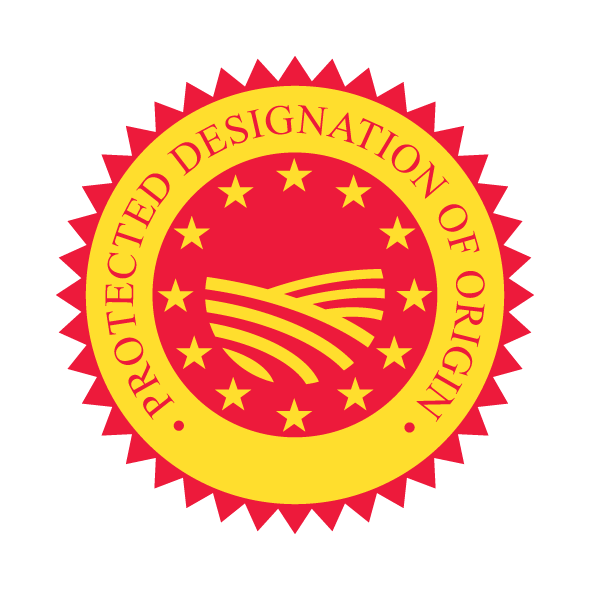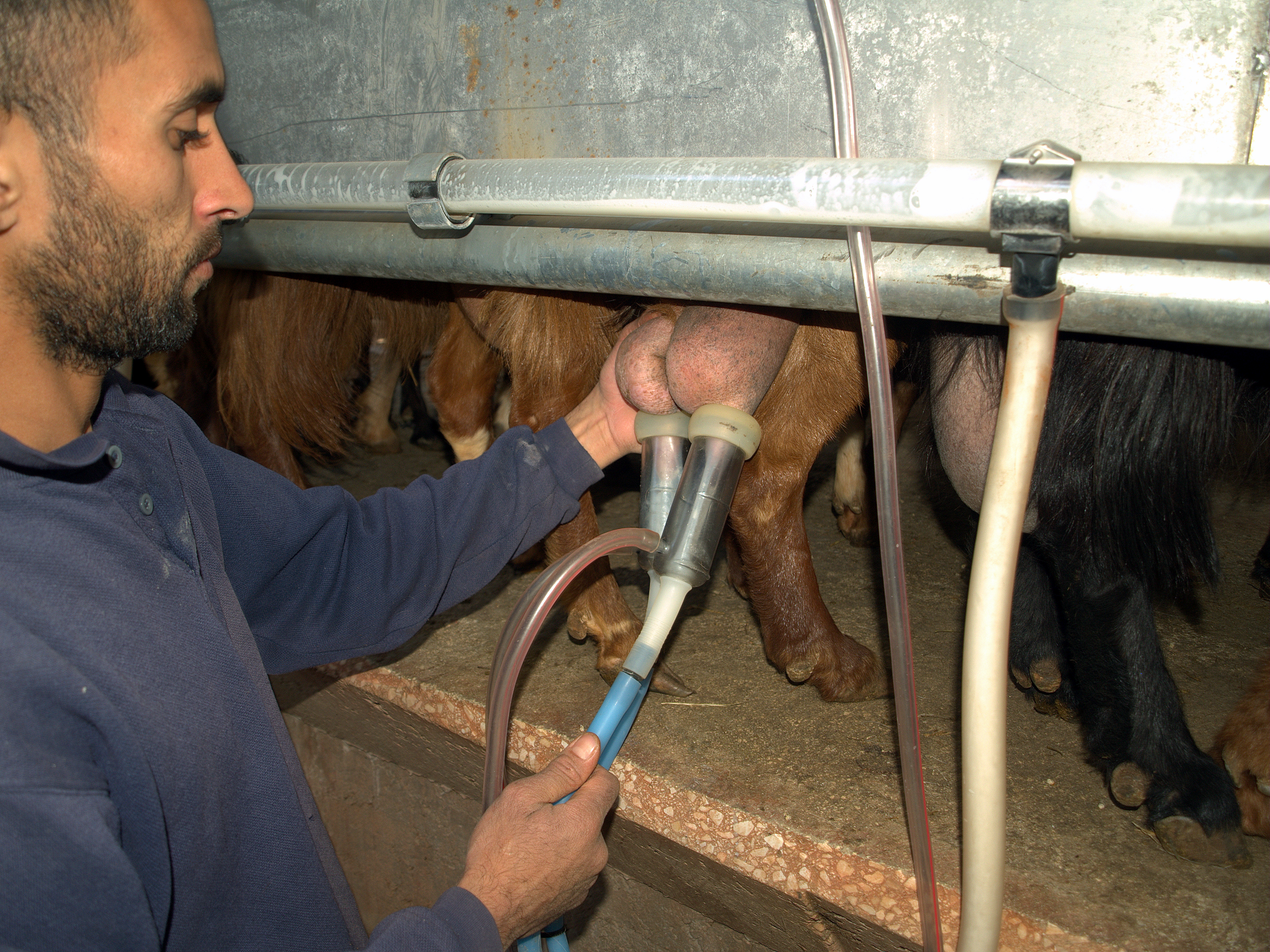|
Graviera
Graviera ( ) is a cheese from Greece produced in various parts of Greece, the main varieties of which are Crete, Lesbos, Naxos and Amfilochia. It resembles gruyère, a Swiss cheese from whose name "graviera" is derived. Graviera is Greece's second most popular cheese after feta. Made in wheels, the hard cheese has its rind marked with the characteristic crisscross pattern of its draining cloth. There are various types of graviera produced in Greece. Graviera of Crete is made from sheep's milk and ripened for at least five months. It is slightly sweet, with a pleasant burnt caramel flavor. The graviera of Naxos, in contrast, is mostly made of cow's milk (80–100%). Graviera can be sliced and eaten, fried as saganaki and eaten as a snack, grated and served over pasta dishes, baked in a casserole or used in salads (in cubes or shavings). It is widely available outside Greece, where it can be purchased at large grocery stores, Greek or ethnic markets, and specialty cheese shops, a ... [...More Info...] [...Related Items...] OR: [Wikipedia] [Google] [Baidu] |
Saganaki
In Greek cuisine, saganaki () () is any one of a variety of dishes prepared in a small frying pan, the best-known being an appetizer of fried cheese. It is commonly flambéed in North America. Etymology The dishes are named for the frying pan in which they are prepared, called a (), which is a diminutive of (), a frying pan with two handles, which comes from the Turkish word , itself borrowed from Arabic (). Description The cheese used in ''saganaki'' is usually graviera, kefalograviera, halloumi, kasseri, kefalotyri, or sheep's milk feta cheese. Regional variations include the use of formaela cheese in Arachova, halloumi in Cyprus, and vlahotiri in Metsovo. The cheese is melted in a small frying pan until it is bubbling and generally served with lemon juice and pepper. It is eaten with bread. Other dishes cooked in a ''saganaki'' pan include ''shrimp saganaki'' (, ), and ''mussels saganaki'' (, ), which are typically feta-based and include a spicy tomato sauce ... [...More Info...] [...Related Items...] OR: [Wikipedia] [Google] [Baidu] |
List Of Cheeses
This is a list of cheeses by place of origin. Cheese is a milk-based food that is produced in wide-ranging flavors, textures, and forms. Hundreds of types of cheese from various countries are produced. Their styles, textures and flavors depend on the origin of the milk (including the animal's diet), whether they have been pasteurized, the butterfat content, the bacteria and mold, the processing, and aging. Herbs, spices, or wood smoke may be used as flavoring agents. The yellow to red color of many cheeses, such as Red Leicester, is normally formed from adding annatto. While most current varieties of cheese may be traced to a particular locale, or culture, within a single country, some have a more diffuse origin, and cannot be considered to have originated in a particular place, but are associated with a whole region, such as queso blanco in Latin America. Cheese is an ancient food whose origins predate recorded history. There is no conclusive evidence indicating wh ... [...More Info...] [...Related Items...] OR: [Wikipedia] [Google] [Baidu] |
Greece
Greece, officially the Hellenic Republic, is a country in Southeast Europe. Located on the southern tip of the Balkan peninsula, it shares land borders with Albania to the northwest, North Macedonia and Bulgaria to the north, and Turkey to the east. The Aegean Sea lies to the east of the Geography of Greece, mainland, the Ionian Sea to the west, and the Sea of Crete and the Mediterranean Sea to the south. Greece has the longest coastline on the Mediterranean Basin, spanning List of islands of Greece, thousands of islands and nine Geographic regions of Greece, traditional geographic regions. It has a population of over 10 million. Athens is the nation's capital and List of cities and towns in Greece, largest city, followed by Thessaloniki and Patras. Greece is considered the cradle of Western culture, Western civilisation and the birthplace of Athenian democracy, democracy, Western philosophy, Western literature, historiography, political science, major History of science in cl ... [...More Info...] [...Related Items...] OR: [Wikipedia] [Google] [Baidu] |
Sheep's-milk Cheeses
Sheep milk is the milk of domestic sheep. It is commonly used to make cultured dairy products, such as cheese. Some of the most popular sheep cheeses include feta (Greece), pecorino romano (Italy), Roquefort (France) and Manchego (Spain). Sheep breeds Specialized dairy breeds of sheep yield more milk than other breeds. Common dairy breeds include: * East Friesian (Germany) * Sarda (Italy) * Lacaune (France) * British Milk Sheep (UK) * Chios (Greece) * Awassi (Syria) * Assaf (Israel) * Zwartbles (Friesland, Netherlands) In the U.S., the most common dairy breeds are the East Friesian and the Lacaune. Meat or wool breeds do not produce as much milk as dairy breeds, but may produce enough for small amounts of cheese and other products. Milk production period Female sheep (ewes) do not produce milk constantly. Instead, they produce milk during the 80–100 days after lambing. Sheep naturally breed in the fall, which means that a majority of lambs are born in the wint ... [...More Info...] [...Related Items...] OR: [Wikipedia] [Google] [Baidu] |
Greek Cheeses
Greek may refer to: Anything of, from, or related to Greece, a country in Southern Europe: *Greeks, an ethnic group *Greek language, a branch of the Indo-European language family **Proto-Greek language, the assumed last common ancestor of all known varieties of Greek **Mycenaean Greek, most ancient attested form of the language (16th to 11th centuries BC) **Ancient Greek, forms of the language used c. 1000–330 BC **Koine Greek, common form of Greek spoken and written during Classical antiquity **Medieval Greek or Byzantine Language, language used between the Middle Ages and the Ottoman conquest of Constantinople **Modern Greek, varieties spoken in the modern era (from 1453 AD) *Greek alphabet, script used to write the Greek language *Greek Orthodox Church, several Churches of the Eastern Orthodox Church *Ancient Greece, the ancient civilization before the end of Antiquity * Old Greek, the language as spoken from Late Antiquity to around 1500 AD *Greek mythology, a body of myths o ... [...More Info...] [...Related Items...] OR: [Wikipedia] [Google] [Baidu] |
Feta
Feta ( ; ) is a Greek brined white cheese made from sheep milk or from a mixture of sheep and goat milk. It is soft, with small or no holes, and no skin. Crumbly with a slightly grainy texture, it is formed into large blocks and aged in brine. Its flavor is tangy and salty, ranging from mild to sharp. Feta is used in salads, such as Greek salad, and in pastries, notably the phyllo-based Greek dishes '' spanakopita'' "spinach pie" and '' tyropita'' "cheese pie". It is often served with olive oil or olives, and sprinkled with aromatic herbs such as oregano. It can also be served cooked (often grilled), as part of a sandwich, in omelettes, and many other dishes. Since 2002, feta has been a protected designation of origin in the European Union (EU). EU legislation and similar legislation in 25 other countries limits the name ''feta'' to cheeses produced in the traditional way in mainland Greece and Lesbos Prefecture, which are made from sheep milk, or from a mixture of sheep ... [...More Info...] [...Related Items...] OR: [Wikipedia] [Google] [Baidu] |
Protected Designation Of Origin
The protected designation of origin (PDO) is a type of geographical indication of the European Union aimed at preserving the designations of origin of food-related products. The designation was created in 1992 and its main purpose is to designate products that have been produced, processed and developed in a specific geographical area, using the recognized know-how of local producers and ingredients from the region concerned. Features The characteristics of the products protected are essentially linked to their terroir. The European or UK PDO logo, of which the use is compulsory, documents this link. European Regulation 510/2006 of 20 March 2006 acknowledges a priority to establish a community protection system that ensures equal conditions of competition between producers. This European Regulation is intended to guarantee the reputation of regional products, adapt existing national protections to make them comply with the requirements of the World Trade Organization, and info ... [...More Info...] [...Related Items...] OR: [Wikipedia] [Google] [Baidu] |
Amfilochia
Amfilochia () is a town and a municipality in the northwestern part of Aetolia-Acarnania in Greece, on the site of ancient Amfilochia. Under the Ottoman Empire, it was known as Karvasaras (Καρβασαράς; from ''caravanserai''). Amfilochia is situated by the Ambracian Gulf and features an amphitheatre. Amfilochia dates back to the ancient times and also features the ancient cities of Amphilochian Argos and Limnaia (or Limnaea). History According to Pausanias, the settlement is named after king Amphilochos, son of Amphiaraus. After the fall of Troy, Amphilochos settled in the area, which consequently was called Amphilochoi until the time of Pausanias. Under the Ottoman Empire, Ali Pasha of Ioannina, forcibly relocated residents of another village to the current location of the town and established a motel (''serai'' in Turkish) to serve passing caravans. This was how the name Karvasaras came up. In July 1944 a battle A battle is an occurrence of combat in warf ... [...More Info...] [...Related Items...] OR: [Wikipedia] [Google] [Baidu] |
Sheep's Milk
Sheep milk is the milk of Sheep, domestic sheep. It is commonly used to make cultured Dairy product, dairy products, such as cheese. Some of the most popular sheep cheeses include feta (Greece), pecorino romano (Italy), Roquefort (France) and Manchego (Spain). Sheep breeds Specialized dairy breeds of sheep yield more milk than other breeds. Common dairy breeds include: * East Friesian sheep, East Friesian (Germany) * Sarda sheep, Sarda (Italy) * Lacaune (sheep), Lacaune (France) * British Milk (sheep), British Milk Sheep (UK) * Chios sheep, Chios (Greece) * Awassi sheep, Awassi (Syria) * Assaf sheep, Assaf (Israel) * Zwartbles sheep, Zwartbles (Friesland, Netherlands) In the U.S., the most common dairy breeds are the East Friesian and the Lacaune. Meat or wool breeds do not produce as much milk as dairy breeds, but may produce enough for small amounts of cheese and other products. Milk production period Female sheep (ewes) do not produce milk constantly. Instead, they produ ... [...More Info...] [...Related Items...] OR: [Wikipedia] [Google] [Baidu] |
Goat Milk
Goat milk is the milk of domestic goats. Goats produce about 2% of the world's total annual milk supply. Some goats are bred specifically for milk. Goat milk naturally has small, well-emulsified fat globules, which means the cream will stay in suspension for a longer period of time than cow's milk; therefore, it does not need to be homogenized. Eventually, the cream will rise to the top over a period of a few days. If the milk is to be used to make cheese, homogenization is not recommended, as this changes the structure of the milk, affecting the culture's ability to coagulate the milk as well as the final quality and yield of cheese. Dairy goats in their prime (generally around the third or fourth lactation cycle) average——(or )—of milk production daily—roughly during a ten-month lactation. Goats produce more after freshening and gradually drop production toward the end of their lactation. The milk generally averages 3.5% butterfat. Сheese Goat milk is commonly ... [...More Info...] [...Related Items...] OR: [Wikipedia] [Google] [Baidu] |



